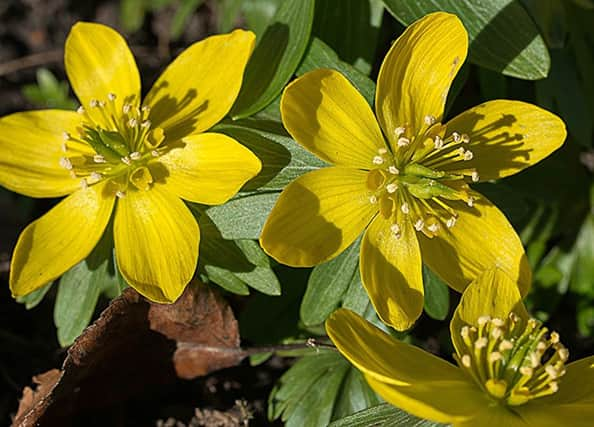Brian Kidd welcomes the arrival of a gem from the mud


The snowdrops are wonderfully in bloom too, spring IS on the way!
The delightful little flowers on the aconites appear out of the mud and they look just like large yellow buttercups. What makes them so special is the pretty frill of green leaves set behind each of the flowers.
Advertisement
Hide AdAdvertisement
Hide AdThese little gems will stay in flower for about six weeks, after which the normal leaves appear so the plant can absorb energy from the sun to guarantee flowers again next spring.
A lot of gardeners find eranthis, the Latin name for this gem, difficult to grow. Even after several attempts nothing ever appears. Well, we can soon put that right.
Instead of planting dry tubers in September, plant them in the green. If you look at gardening magazines you will see advertisements for aconites and snowdrops ‘in the green’. This means they will be available now and if planted as soon as they arrive will produce flowers this time next year.
Choose a place in the garden with partial shade. Any soil will do, even clay. Plant the tubers about two inches deep and two inches apart in a little group where they can naturalise. Make sure you write a label so you don’t disturb them until they become overcrowded.
Advertisement
Hide AdAdvertisement
Hide AdYou may think that most unlikely in your garden, but just you wait and see. If planted in the green, they very soon settle down and will provide you with a great deal of pleasure over many years.
Where do nurseries get these wonderful plants from in the green?
They are grown from seed in excellent planting situations, often in small fields, and after about 18 months the tubers have formed and the leaves are really healthy because they are free from virus and have what is known as hybrid vigour. We could all do with some of that at this time of year.
If you already have some aconites in the garden, sprinkle about half-an-inch of fine gravel over the top of the soil surrounding the flowers so the rain won’t splash mud all over the blooms.
Advertisement
Hide AdAdvertisement
Hide AdI am conscious of the fact that a lot of you enjoy reading about gardening, simply because you write to me.
At the same time, many of you would like a garden but live in an apartment.
Well, there’s no reason for you to be left out.
Winter aconites are wonderful in pots, indoors on a cold windowsill or outdoors in a light spot. They are totally hardy.
If you decide to have a try, ‘dumpy’ pots used for potted chrysanthemums are a good choice because aconites do not make a deep root.
Advertisement
Hide AdAdvertisement
Hide AdPlant the tubers in the green in a couple of weeks, as soon as they arrive from the grower. Choose John Innes No1 or 2 compost and plant the tubers only about an inch deep and quite close together in the pot, as close as an inch apart.
The foliage will come along nicely. It will die down completely by the end of August and you will be left with a pot of compost all winter, but... next January you will be thrilled to bits to see the lovely golden yellow flowers lying flat on the top of the pot complete with the pretty green choirboy frill and you will then see just how easy they were to grow.
TIP OF THE WEEK
If you are thinking about cleaning the pond, do it before the frogs and toads begin to spawn.
If they are already active, simply remove sludge from the bottom of the pond and split up water lilies and replant them in baskets.